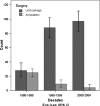Does increased rate of limb-sparing surgery affect survival in osteosarcoma?
- PMID: 20559766
- PMCID: PMC2947695
- DOI: 10.1007/s11999-010-1423-4
Does increased rate of limb-sparing surgery affect survival in osteosarcoma?
Abstract
Background: The emergence of limb salvage surgery as an option for patients with osteosarcoma is attributable to preoperative chemotherapy and advancements in musculoskeletal imaging and surgical technique. While the indications for limb salvage have greatly expanded it is unclear whether limb salvage affects overall survival.
Questions/purposes: We asked whether over the past three decades limb-sparing procedures in high-grade osteosarcoma had increased, and whether this affected survival and ultimate amputation.
Methods: We retrospectively reviewed 251 patients with high-grade osteosarcoma treated from 1980 to 2004 with a multidisciplinary approach, including neoadjuvant chemotherapy. We compared survival rates, limb-salvage treatment, and amputation after limb-sparing procedure during three different periods of time. Fifty-three patients were treated from 1980 to 1989, 97 from 1990 to 1999, and 101 from 2000 to 2004. Thirty-seven patients were treated with primary amputations and 214 with primary limb salvage.
Results: The 5-year survival rate in the first period was 36%, whereas in the 1990 s, it was 60% and 67% from 2000-2004. Limb salvage surgery rate in the 1980s was 53% (28 of 53), whereas in the 1990 s, it was 91% (88 of 97) and 97% from 2000-2004 (98 of 101). In the limb salvage group, 22 of the 214 patients (10%) required secondary amputation; the final limb salvage rate in the first period was 36% (19 of 53), whereas in the 1990 s, it was 81% (79 of 97) and 93% from 2000-2004 (94 of 101).
Conclusions: Patients with osteosarcoma treated in the last two periods had higher rates of limb salvage treatment and survival, with lower secondary amputation.
Figures




References
-
- Bacci G, Ferrari S, Longhi A, Forni C, Bertoni F, Fabbri N, Zavatta M, Versari M. Neoadjuvant chemotherapy for high grade osteosarcoma of the extremities: long-term results for patients treated according to the Rizzoli IOR/OS-3b protocol. J Chemother. 2001;13:93–99. - PubMed
-
- Bacci G, Forni C, Longhi A, Ferrari S, Mercuri M, Bertoni F, Serra M, Briccoli A, Balladelli A, Picci P. Local recurrence and local control of non-metastatic osteosarcoma of the extremities. A 27-year experience in a single institution. J Surg Oncol. 2007;96:118–123. doi: 10.1002/jso.20628. - DOI - PubMed
MeSH terms
LinkOut - more resources
Full Text Sources
Medical
Miscellaneous

